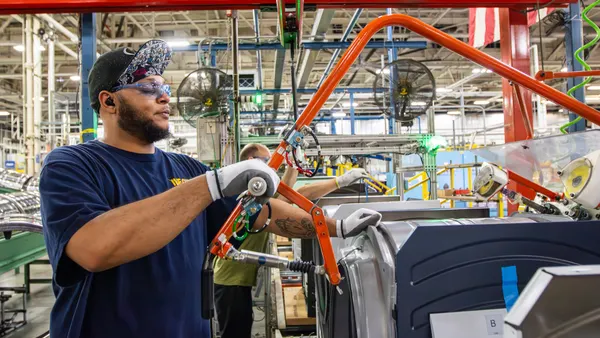Dive Brief:
- Ryder partnered with Fetch Robotics to bring a number of emerging technology solutions to existing warehouse locations in Miami, Dallas and Chicago.
- The use of robotics alone has resulted in a 25% increase in productivity and 20% operating savings by reducing the travel time within the warehouses, according to the company.
- Increased automation is meant to help customers meet the demand generated by omnichannel, rising consumer expectations and a nationwide warehouse labor shortage, Steve Sensing, Ryder president of global supply chain solutions, said in a statement.
Dive Insight:
Warehouse operators are increasingly focused on the opportunity to increase efficiency with robotics. Along with robotics, Ryder also began using drones, sensors and wearable technology in the three locations.
Ryder chose these three facilities based on the customers' interest in automation and the kind of product being handled in the facilities. The company declined to share further details on the nature of the customers and what exactly is coming through these warehouses.
For robotics, Ryder looked for use cases where processes were repeatable and where the use of automation could prevent human injury. One of these jobs is the staging of inventory within warehouses.
"Also, automation is ideal for performing movements within a warehouse that are not time-critical and may cover long distances," Sensing, said in an email to Supply Chain Dive.
But moving this inventory is hard if you don't know where it is, which is where drones come into play. Ryder has outfitted drones with tech that makes them able to act as flying inventory counters. In one case, drones were able to scan in 20 minutes the number of pallets that would normally take a human 90 minutes, the company said.
"The amount of drones you would deploy in a facility would depend on the layout and size," Sensing said. "We are looking to deploy these into more distribution management sites and also exploring the ability to perform yard checks."
Human workers are getting an upgrade in these warehouses, too. Ryder has begun using smart glasses to overlay order details into the wearer's field of vision, providing them with confirmation they're in the right place and retrieving the right package. This eliminates the need to constantly check a computer for information, and it makes it easier to train new employees on the picking process, as training videos can be loaded onto the glasses, Hendricks said.
A warehouse isn't truly smart, however, until it's outfitted with plenty of sensors. And Ryder has installed sensors into these warehouses that provide a granular understanding of what is happening on the floor at any given moment — tracking the location of materials, equipment and personnel.
"At the end of the day, it is a way to eliminate waste and find efficiencies, as well as give insight into areas that could be automated in the future to find cost savings," Sensing said.
Tying all these technologies — and future technologies — together is a cloud-based "advanced robotics platform" from Fetch Robotics that aids in data collection and robotic management.
"This digital supply chain strategy sets Ryder up for access to real-time data across an entire operation," Sensing said, "which is the end goal."
Correction: This article was updated to attribute quotes to Ryder President of Supply Chain Solutions Steve Sensing.













